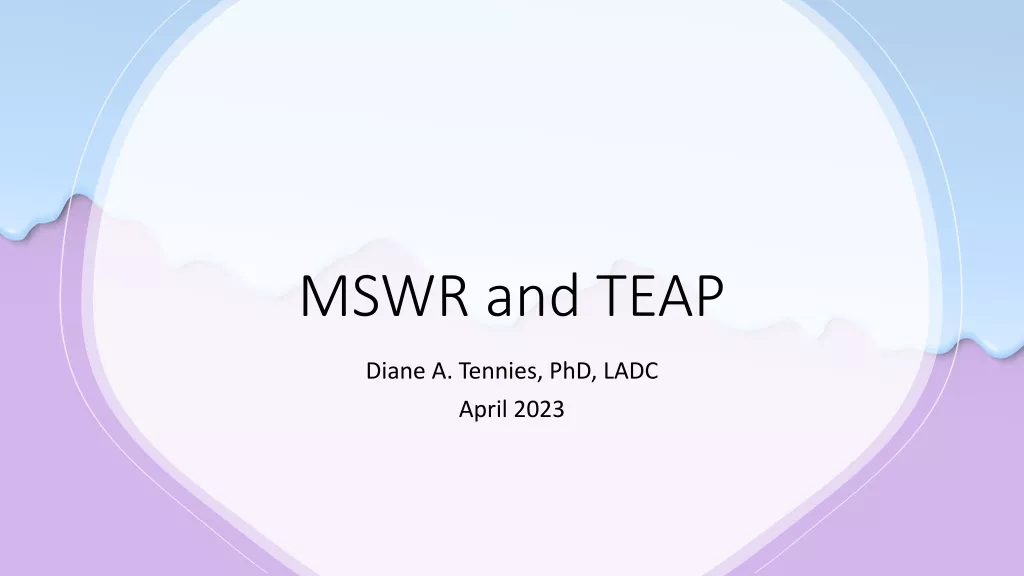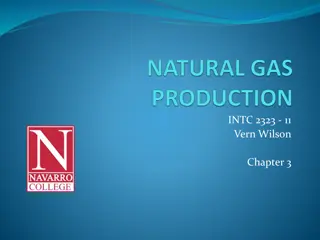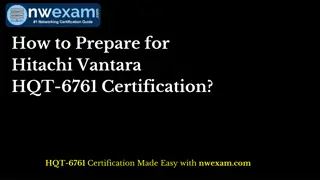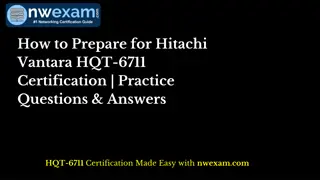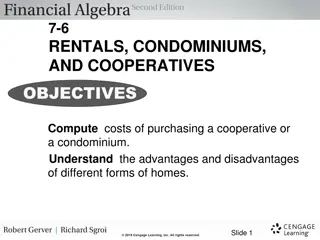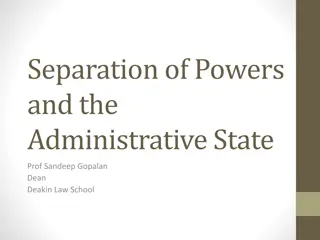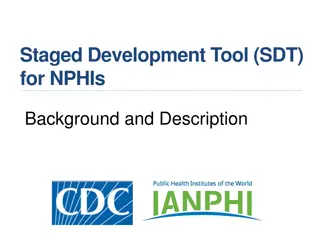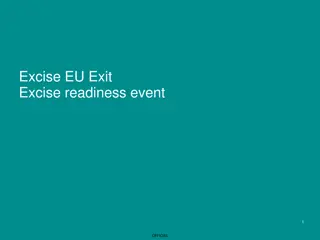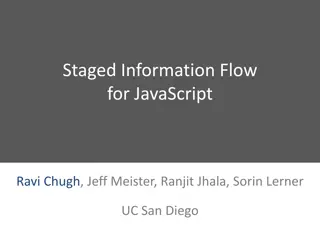ASPEN Staged Separation Unit-Ops
Introduction to Aspen Staged Separation Unit Operations for the purification of desired components by removing impurities and pollutants using distillation, absorption, and stripping columns. This technology is relevant to ammonia synthesis to prevent catalyst poisoning by removing CO2 through absorption and stripping techniques. Chemical absorption/stripping using solvents like Monoethanolamine and Potassium Carbonate is commonly preferred to minimize waste of hydrogen. Aspen simulation setup for Physical Absorption Columns involves adding components, choosing property base methods, and defining properties of inlet streams for efficient CO2 removal.
Download Presentation

Please find below an Image/Link to download the presentation.
The content on the website is provided AS IS for your information and personal use only. It may not be sold, licensed, or shared on other websites without obtaining consent from the author.If you encounter any issues during the download, it is possible that the publisher has removed the file from their server.
You are allowed to download the files provided on this website for personal or commercial use, subject to the condition that they are used lawfully. All files are the property of their respective owners.
The content on the website is provided AS IS for your information and personal use only. It may not be sold, licensed, or shared on other websites without obtaining consent from the author.
E N D
Presentation Transcript
ASPEN Staged Separation Unit-Ops Samaa Zaman, Lane Crofton, Elina Tabarzadi, Tran Do and Michael Schachter CHBE446: Design 2 5 February 2024
Introduction: Stage Separation Unit-Ops Industrial Uses: Purify desired components Removing impurities and pollutants Major unit-ops include: Distillation Columns Absorption Columns Stripping Columns
Relevance to Ammonia Synthesis Undesirable pollutants produced Primarily CO2 Removed via separation techniques prior to reactor to prevent catalyst poisoning The removal of carbon dioxide is commonly performed using a combination of absorption and stripping columns
Carbon Dioxide Removal Techniques Carbon dioxide can be removed via both physical and chemical absorption/stripping Industrially, chemical methods have been preferred Leads to minimize waste of hydrogen Common solvents used in the chemical absorption/stripping process include: Monoethanolamine (MEA) Potassium Carbonate (K2CO3)
ASPEN Physical Absorption Column: Basic Setup Step 1: Begin new ASPEN simulation Step 2: Add all components from process Step 3: Choose a property base method that best fits your components Ex. Wilson which utilizes Henry s Law
ASPEN Physical Absorption Column: Simulation Setup Step 1: Add RADFRAC column to flowsheet Step 2: Add 2 inlet streams to RADFRAC column Can be useful to label as liquid and gas feed Step 3: Add both a distillate and bottoms stream For absorption the distillate is the desired vapor product with impurities removed
ASPEN Physical Absorption Column: RADFRAC Setup (1) Step 1: Define properties of both inlet streams based upon process information Includes flow rates, composition, temperature, pressure, etc. Step 2: Under the configuration tab for the column, choose the following options
ASPEN Physical Absorption Column: RADFRAC Setup (2) Step 1: Under the streams tab for the column, choose the following options Liquid feed should enter at the top of the column Gas feed should enter at the bottom
ASPEN Physical Absorption Column: RADFRAC Setup (3) Step 1: Under the pressure tab for the column, enter the operating pressures for both stages This will depend on the process being used Ex. operating close to atmospheric pressure
ASPEN Physical Absorption Column: RADFRAC Setup (4) Step 1: On the side panel navigate to Blocks -> Your RADFRAC Column -> Column Internals Step 2: Select Add New and double click on the new internals Step 3: Scroll to the right and select the view option
ASPEN Physical Absorption Column: RADFRAC Setup (5) Step 1: Fill out the following screen based upon the specifications of your desired packing materials Make sure that the rating option is selected, otherwise you will have incomplete errors
ASPEN Physical Absorption Column: RADFRAC Setup (6) Step 1: On the side panel navigate to Blocks -> Your RADFRAC Column -> Rate-Based Modeling Step 2: Check the box for Rate-based calculation Step 3: Run your simulation!
ASPEN Chemical Absorption Column: RADFRAC Setup (1) Choose the Electrolytes Template
ASPEN Chemical Absorption Column: RADFRAC Setup (2) Step 1: Under Properties, components; Input the required components for the process. Step 2: Choose the Elec Wizard option to define the ionic species and salts that can be generated from the base components.
ASPEN Chemical Absorption Column: RADFRAC Setup (2) Step 1: Under Methods, choose ELECNRTL, which is electrolyte NRTL model with Redlich- Kwong EOS.
ASPEN Chemical Absorption Column: RADFRAC Setup (3) Step 1: Select the base components for electrolyte chemistry generation. Step 2: Select Hydrogen ion type. Step 3: Include salt formation and water dissociation reaction.
ASPEN Chemical Absorption Column: RADFRAC Setup (4) Step 1: Remove not relevant generated Species and their reactions
ASPEN Chemical Absorption Column: RADFRAC Setup (6) Step 1: Under Chemistry, Global; Verify the reactions from Elec Wizard. Step 2: Add any additional reaction with New button. Step 3: Choose reaction type, and insert component and coefficient.
ASPEN Chemical Absorption Column: RADFRAC Setup (7) Step 1: Build the process flow diagram using the Radfrac ABS unit model. Step 2: Specify the process inlet streams.
ASPEN Chemical Absorption Column: RADFRAC Setup (8) Step 1:On the set up page of Radfrac, select Rate-Based. Step 2: Input the number of stages. Note: Equilibrium model does not enable determining the options for parameters such as type and amount of packed bed. Step 3: Select the best convergence based on the 2-phase mixture.
ASPEN Chemical Absorption Column: RADFRAC Setup (9) Step 1: Under the stream tab, input the feed(s) stage entry location and convention. Note: The top stage in Aspen Plus is always 1. So the Liquid feed enters above-stage 1. On-stage, enters the other feeds to that specified stage. Step 2: Input the product stream output stage.
ASPEN Chemical Absorption Column: RADFRAC Setup (10) Step 1: Under the pressure tab, enter the operating pressure for stage 1. Pressure drop and other stages pressure, is optional.
ASPEN Chemical Absorption Column: RADFRAC Setup (11) Step 1: Under Column internals, define a new (INT-1). Step 2: Enter the start and end stage of the section, packed height and diameter. Step 3: Change Mode from default to Rating. Step 4: Choose the best internal and Packing type for the mixture.
ASPEN Chemical Absorption Column: RADFRAC Setup (12) Step 1: Under the Rate- based modeling, select rate-based set up. Step 2: For flow model select mixed, or counter current. Note: In the mixed flow model, bulk properties for each phase are the same as outlet condition. In the counter-current, the properties of each phase are an average of the inlet and outlet.


